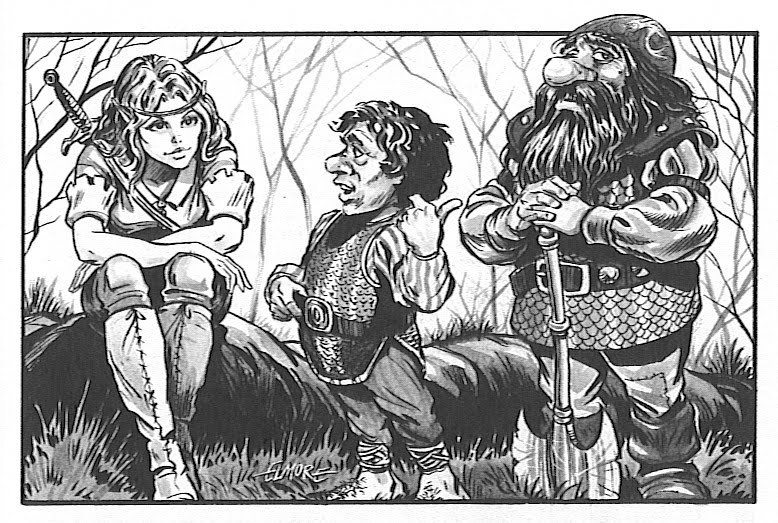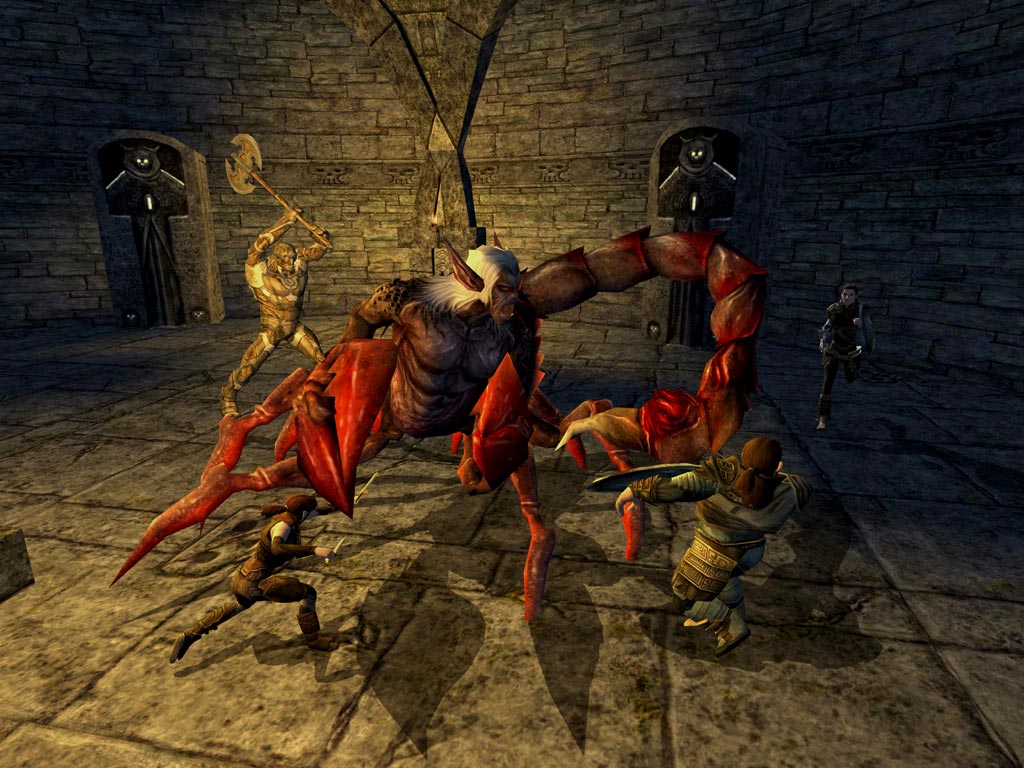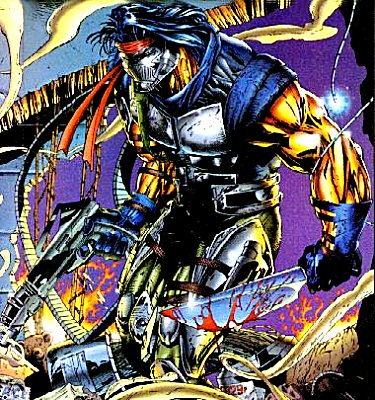 As with the races of law, refer to prior blog entries for expanded data on each race; what follows is a short summary plus S&W statistics:
The Chaos Races
Dark Elves (Ashtarth):
As with the races of law, refer to prior blog entries for expanded data on each race; what follows is a short summary plus S&W statistics:
The Chaos Races
Dark Elves (Ashtarth): Members of the renegade sorcerer clan of the silver elves, these chaos-tainted dark elves have evolved a sophisticated culture of demon worship.
Dark elves are like normal elves in all ways with the following differences:
Attribute Modifiers: +1 Dex, -1 Con; female Ashtarth gain +1 Cha as well.
Favored Classes: ranger, thief, magic-user, cleric. assassin
Racial Spells: once per day each: faerie fire, darkness 15' radius. 10% of ashtarth can levitate at will.
Orcs (Anyu): The orcs come in many varieties, from the civilized but still brutal grey orcs to the malicious chaos-tainted blue and red orcs and the xenophobic fell manorg of the north. They are a threat to all humankind, and few of their number are civil enough to interact with other races.
Average Height: 4’6” to 7’ feet tall; orcs vary widely in size
Average Weight: 100-350 lbs.
Languages: ogcish, plus one other (usually the middle tongue, ogreish or goblin)
Ability Scores: +1 Str, -1 Int
Favored Classes: assassin, fighter, thief
Vision: darkvision 120 feet
Light Blind: orcs fight at a -1 penalty to attacks in sunlight or other bright light (torch light is okay)
Half Orc Adventurers
In S&W, half orcs have darkvision for 60 feet but do not suffer penalties to battle in sunlight.
Ability Scores: They are stronger (+1 strength) but suffer for their mixed heritage (-1 charisma).
Favored Classes: assassin, fighter, thief
Red Orcs
Red Orcs are treated somewhat differently than normal orcs, and have normal average intelligence and strength (no modifiers)
Red orc may treat cleric and magic user as favored classes
Gul'hlath Black Orcs
Black orcs gain a 2 point armor bonus
Fell Manorg
Fell Manorg receive a +2 save bonus against cold effects and spells (breath attacks, cone of cold, etc.)
Fell Manorg may never start with another language other than orcish, goblin, minotaur, giantish or draconic.
All Fell Manorg start off illiterate (which precludes them from starting at 1st level as a wizard) and must use a language slot from intelligence to learn one form of writing
Green Orcs
Green Orcs are natural experts at jungle camouflage and survival, and receive a +10% racial modifier to all attempts at stealth (move silently, hide in shadows) in a jungle environment.
Naga: An aquatic race of evil beings who have risen to power and now aspire to conquer the dry lands of the world.
Height: 5’5” to 6”
Weight: 150-180 lbs.
Languages: Naga, common, and other options include draconic, infernal, and orcish.
Attributes: +1 Dexterity, -1 Constitution
Favored Classes: cleric, fighter, thief, magic user
Optional Racial XP Modifier: -10%
Deep Vision: Naga deep vision functions equally well underwater as well as in darkness. They can see in shades of grey even in total darkness.
Amphibious: Naga can breathe normally on land and under water with no impairment. Note that this does not protect them from unnatural attacks such as stinking cloud.
Natural Swimmer: All naga are excellent swimmers, and move at full speed when swimming.
Armored Scales: Naga are scaled, and these scales provide natural armor protection, offering a natural 2 point armor class bonus.
Tail Strike: Naga can smack with their tails for 1D3 damage, and get a +1 bonus to attack when trying to trip with their tails.
Gnolls: The gnolls are a demonic race that seeks to overcome the dominance of the orcs in the underworld races and to establish themselves as the principle legions of chaos.
Gnolls are by and large an unfriendly fringe race, but if your campaign tends to avoid urban humanocentric regions in favor of the vast wilderlands inhabited by other monsters then gnolls may be especially suited to your particular games.
Height: 5’4” to 6’6” tall
Weight: 100-250 lbs.
Languages: gnollish, goblin, orcish, giantish, demonic
Ability Scores: +1 Con, -1 Int
Favored Classes: cleric (of chaos), fighter, thief
Bite: gnolls have a deadly bite that does 2D4 damage.
Sherigras: These chaos-tainted beings were once human, and long ago their kind descended in to chaos and madness, pursuing the dark arts and worshipping the dread gods of the Abyss. Marked by skeletal, gaunt features, the Sherigras exist where they are allowed, on the fringes of society.
Average Weight: 65 to 150 lbs.
Average Height: 5’1” to 6’6”
Languages: middle tongue and abyssal
Favored Classes: cleric, thief, magic user
Ability Scores: +1 Dex, -1 Cha
Vision: dark vision
Optional Racial XP Penalty: -15%
Chaotic Alignment: Sherigras are by their very nature aligned with chaos.
Mark of Chaos: Sherigras are tainted by an aura of chaos that is easily sensed by most creatures if they do not try to hide it. This penalty makes commoners, children, animals and other beings sense a vague sort of unease in their presence, and can lead to strong negative reactions from normal folk.
Taint of Chaos: The taint of chaos can be used as a weapon. Once per day, by concentrating, a Sherigras can project the aura, treating it like a fear spell with a 30 foot radius of effect from their person.
Chaos Affinity: Sherigras are attuned to chaotic energies, and have a 3 in 6 chance that they can feel the presence of planar beings and objects which are attuned to Order or Chaos (such as demons and angels or artifacts) when such creatures are within visible range.
Manifestation of Chaos: Long ago before the cataclysm Sherigras were so attuned to chaos that efforts to advance the indelible cause of their dark gods rewarded them with strange side effects, and efforts to oppose their nature led to punishment. After the cataclysm this effect lifted, and sherigras have since been freed of their dark tether to chaos, although their bodies remain wracked with corruption. Choose or roll one trait from the following list, and gain that as your chaotic affinity; each affinity grants a penalty and a bonus accordingly:
Sherigras Chaotic Affinity Table, S&W Version(D100)
1-10: hideously skeletal; you suffer an additional -2 modifier to your Con score but may use your chaos affinity fear effect twice per day.
11-20: Permanent Blindness; you permanently suffer from blindness, but gain the ability to cast invisibility once per day.
21-25: Permanent loss of one arm, but you gain a flexible tentacle which provides a +10% bonus to Delicate Tasks, Opening Locks and a +5% bonus to Picking Locks.
26-30: You have hideous claws instead of hands. You gain a natural claw attack that does 1D4 damage and can be treated as two-weapon attacks, but you suffer a -10% penalty to Delicate Tasks, Open Locks and any other check requiring fine manipulation.
31-35: You have a serpent’s tail instead of legs. You can swim at double your movement speed, and can make a constriction attack that deals 1D4 subdual damage. You suffer all the reasonable restrictions accompanied by having a serpent’s body instead of normal legs.
36-40: A Visible black nimbus of chaos energy surrounds you, visible to anyone and disguisable only by illusions (spells); However, you become more resistant to undead level drain effects and on a saving throw with a +2 bonus will be unaffected by a level drain attack.
41-50: A Third eye rests in your forehead; it grants periodic visions as determined by the GM and you gain a +2 save bonus to any saving throw against a blindness or vision-imparing effect.
51-60: A demonic face appears in your torso, which must be fed and speaks a lot (double your daily intake of rations, and take a -15% penalty on Move Silently checks if you don’t gag it). You can cast spells using this mouth even if you are gagged normally, and can perform unusual acts of ventriloquism.
61-70: Animals will instinctively attack you on site, without exception, even if you have some sort of animal empathy. However, all aberrations, undead and outsiders of at least animal intelligence react to you as if you are at least not hostile, if not actual kin, and you may cast charm monster once per day.
71-80: Blistery Black Boils cover your body from head to toe giving you a -2 reduction to your Charisma, but you are immune to disease and any exposure to a disease to which you fail a saving throw on makes you a carrier for that disease, instead.
81-90: You have perpetual stigmata, bleeding from spontaneous wounds, your eyes, and elsewhere constantly. Once per day if you are reduced to negative hit points you may make a saving throw with a +2 bonus; if you succeed, then you stabilize at 1 hit point.
91-95: You have the head of an animal; you may choose the animal and gain a natural attack appropriate to the type you chose (i.e wolves get a 1D4+1 bite), as well as a natural animal empathy for those animals and the ability to communicate with them.
96-00: You appear to be outwardly normal, but at nighttime your skin disappears and you seem to bleed continually. In addition to being easy to track, you no longer suffer as grievously from cutting and slashing wounds, instead reducing all such damage by 1 point (to a minimum of 1) while this is in effect. However, you are of such a monstrous appearance that normal social interactions are almost impossible. Think “Hellraiser.”
Ghuls: The flesh-eaters of Lingusia are half-undead survivors of undead plagues who retained their wits if not their sanity and formed a new race of deformed beings, many of whom serve Orcus and other demon gods.
Average Weight: 100 to 250 lbs.
Average Height: 5’2” to 6’6”
Languages: ghoulish, middle tongue, and access to most monstrous languages
Favored Classes: assassin, thief, cleric, magic user
Ability Scores: +1 Con, -1 Cha
Optional Racial XP Penalty: -10%
Vision: dark vision
Cannibalism: Ghuls gain strength from cannibalism. They do not need to eat fresh meat; there is much truth to the idea of ghuls seeking out corpses and carrion. Once per day, Ghuls who spend a minute or more devouring a humanoid corpse may regain 1D3 hit points.
If a ghul goes a day without eating humanoid flesh, then he does not heal 1 HP at the end of the day as he normally would. After one month of resisting cannibalism he will lose 1 HP per day. This continues until he resumes his cannibalistic ways or eventually is wounded and dies, after which he turns in to a normal undead ghoul.
Although the notion of cannibalism applies to eating members of one’s own species, ghuls find that the flesh of any demihuman will do just fine, be it elf, orc, dwarf, halfing or gnome. Humanoids that are not mammalian such as lizard men, kobolds, marlacks and so forth will also suffice, although they taste disgusting to the ghul palette.
Disease Resistance: Ghuls gain a +2 saving throw bonus to resist disease.
Putrefying Smell: Ghuls can emit a terrible stench twice per day which can have an adverse impact on nearby enemies and allies alike. All creatures within 15 feet of a ghul that emits the stench must make a saving throw against poison or suffer nausea and weakness, instilling a -1 penalty to attack rolls and other checks.
Deep Dwarves (Darendur): The deep dwarves were once a chaos-tainted race themselves, though many of their kind have emerged from the deepest regions of the Lower Dark and renounced the chaos gods. Some still adhere to the old ways, though, and regardless of their affiliation, the deep dwarves are still marked by chaos.
Darendur are like all other dwarves, save for the following differences:
Languages: Deep Speech, plus one other (usually Tradespeak or Giantish)
Ability Scores: +1 Con, -1 Cha
Favored Classes: assassin, fighter, thief
Restricted Classes: Darendur are barred from any spell-casting class, as they are unable to work magic.
Optional Racial XP Penalty: -15%
Magical Sensitivity: All darendur have a curious innate ability to tell what sort of magic an item is, much as if they had cast detect magic. Darendur may identify magic items in this manner merely by touch (they don’t even need to study them visually).
Dark Vision: Darendur have Darkvision of 120 feet, being atuned to the lightless depths of their subterranean homes. They need no light source to see in a series of black and white shades, able to rely on a form of infrared to see.
Light Sensitive: All darendur are light-sensitive, and experience blindness for one round if exposed to a sudden daylight-like effect (such as a spell or unexpected sunlight), and normaly fight with a -1 penalty when in light brighter than a torch thereafter.
Magic Resistance: Darendur have a strange resilience against magic, and have a +2 bonus to saves against it.
Trolls (Thargonids, Mihidir): The trolls are an ancient race, and while the thargonids are horribly corrupted by chaos, the mihidir still retain a trace of their ancient, proud lineage.
Average Height: 7’ to 7’6” tall (males) or 6’ to 6’6” for females
Average Weight: 250-350 lbs.
Languages: Trollish, plus one other (usually Tradespeak or Deep Speech)
Favored Classes: assassin, thief
Ability Scores: +1 intelligence and -1 charisma
Vision: Dark Vision 120 feet
Optional Raciail XP Miodifier: -20%
Regeneration: Mihidir trolls heal at an amazingly fast rate, recovering one hit point per round of battle. Only fire and acid damage does not regenerate.
Claws and Teeth: Mihidir are well armed with natural attacks; their bite does 1D3 damage and claws do 1D4 damage.
 Next: Neutral Kindred in S&W!
Next: Neutral Kindred in S&W!





















